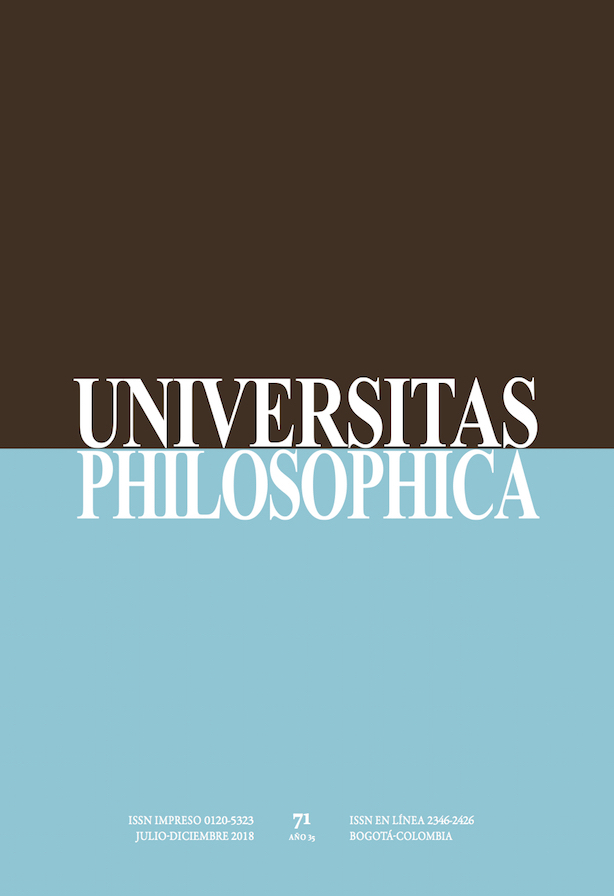Abstract
The purpose of this article is to show how the use of certain terms of theatre, that are employed to describe philosophical procedures or concepts, reveals two different kinds of relations between philosophical discourse and artistic practices: On the one hand, some philosophers make a conscious and metaphorical use of the vocabulary of scenic practices to describe their own operations; on the other, the technical and historical determinations of these practices open up new interpretations of philosophical constructs, even though, at first, they were not intended to do so by the authors that exploit them. To fulfil this purpose, this article analyzes significant moments of contemporary French thought—where there are frequent expressions such as scene and dramaturgy—, in order to trace the genealogy of that philosophical interest and explore a series of descriptions of the theory and practice of classical French theatre.
Aristóteles. (1999). Poética. Madrid: Gredos.
Badiou, A. (2004). El siglo. Buenos Aires: Manantial.
Badiou, A. (2005). Teatro y filosofía. Imágenes y palabras. Escritos sobre cine y teatro (pp. 115-135). Buenos Aires: Manantial.
Badiou, A. (2010). Segundo manifiesto por la filosofía. Buenos Aires: Manantial.
Badiou, A. (2015a). Éloge du théâtre. Paris: Flammarion.
Badiou, A. (2015b). Rapsodia por el teatro. Buenos Aires: Adriana Hidalgo Editora.
Bardet, M. (2011). Penser et mouvoir. Une rencontre entre danse et philosophie. Paris: L’Harmattan.
Brecht, B. (2004). Escritos sobre el teatro. Barcelona: Alba.
Claudel, P. (1956). Conversation sur Jean Racine. Paris: Gallimard.
Corneille, P. (1987). Trois discours sur le poème dramatique. OEuvres complètes (Tome III). Paris: Gallimard.
D’Aubignac. (2011). La pratique du théâtre. Paris: Honoré Champion.
Deleuze, G. (2002). Diferencia y repetición. Buenos Aires: Amorrortu.
Derrida, J. (1992). La escritura y la diferencia. Barcelona: Anthropos.
Derrida, J. (2015). La diseminación. Madrid: Fundamentos.
Diderot, D. (1876). OEuvres complètes. Tome onzième. Salon de 1767. Paris: Garnier Frères, Libraires-éditeurs.
Diderot, D. (1981). Paradoxe sur le comédien. Précédé des Entretiens sur le Fils naturel. Paris: Flammarion.
Didi-Huberman, G. (2007). La invención de la histeria. Charcot y la iconografía fotográfica de la Salpêtrière. Madrid: Ediciones Cátedra.
Foucault, M. (1994a). Theatrum philosophicum. Dits et écrits (Tome II). Paris: Gallimard.
Foucault, M. (1994b). La scène de la philosophie. Dits et écrits (Tome III). Paris: Gallimard.
Freud, S. (1992). De la historia de una neurosis infantil. Obras completas. De la histoira de una neurosis infantil (el “Hombre de los lobos”) y otras obras (1917- 1919). Buenos Aires: Amorrortu.
Hallward, P. (2006). Jacques Rancière et la théâtrocratie. En: L. Cornu & P. Vermeren (Eds.). La philosophie deplacée. Autour de Jacques Rancière (pp. 483-
489). Bourg en Bresse: Horlieu Éditions.
Kirkkopelto, E. (2009). The Question of the Scene: On the Philosophical Foundations of Theatrical Antropocentrism. Theater Research International,
34(3), 230-242. doi:10.1017/S0307883309990034
Lacan, J. (2014). Seminario 6. El deseo y su interpretación. Buenos Aires: Paidós.
Lacoue-Labarthe, P. (2002). La poétique de l’histoire. Paris: Éditions Galilée.
Lacoue-Labarthe, P., & Nancy, J-L. (2013). Scène. Paris: Christian Bourgois.
Proust, F. (1994). L’Histoire à contretemps. Paris: Les Éditions du Cerf.
Proust, F. (1997). De la résistence. Paris: Les Éditions du Cerf.
Quinet, A. (2010). L’inconscient structuré comme un théâtre. Savoir et clinique, 1(12), 188-195.
Rancière, J. (2006). Thinking between Disciplines: an Aesthetics of Knowledge. Parrhesia, 1, 1-12.
Rancière, J. (2007). El teatro de las imágenes. En: A. Valdés. (Ed.). La política de las imágenes (pp. 69-91). Santiago de Chile: Metales Pesados.
Rancière, J. (2009a). El reparto de lo sensible. Estética y política. Santiago de Chile: ARCES-LOM.
Rancière, J. (2009b). La palabra muda. Ensayo sobre las contradicciones de la literatura. Buenos Aires: Eterna Cadencia.
Rancière, J. (2010). El desacuerdo. Buenos Aires: Nueva Visión.
Rancière, J. (2013). Aisthesis. Escenas del régimen estético del arte. Buenos Aires: Manantial.
Rancière, J. (2014). El método de la igualdad. Conversaciones con Laurent Jeanpierre y Dork Zabunyan. Buenos Aires: Ediciones Nueva Visión.
Rancière, J. (2015). El hilo perdido. Ensayos sobre la ficción moderna. Buenos Aires: Manantial.
Rousseau, J.-J. (1995). Lettre à D’Alambert. OEuvres complètes. Tome V. Écrits sur la musique, le langage et le théâtre. Paris: Gallimard.
Scherer, J. (1986). La dramaturgie classique en France. Paris: Nizet.
Szondi, P. (2011). Teoría del drama moderno (1880-1950). Tentativa sobre lo trágico. Madrid: S. L.-Dykinson.
Wardhaugh, J. (2017). Popular Theater and Political Utopia in France 1870- 1914. Active Citizens. Londres: Palgrave Macmillan.
This journal is registered under a Creative Commons Attribution 4.0 International Public License. Thus, this work may be reproduced, distributed, and publicly shared in digital format, as long as the names of the authors and Pontificia Universidad Javeriana are acknowledged. Others are allowed to quote, adapt, transform, auto-archive, republish, and create based on this material, for any purpose (even commercial ones), provided the authorship is duly acknowledged, a link to the original work is provided, and it is specified if changes have been made. Pontificia Universidad Javeriana does not hold the rights of published works and the authors are solely responsible for the contents of their works; they keep the moral, intellectual, privacy, and publicity rights.
Approving the intervention of the work (review, copy-editing, translation, layout) and the following outreach, are granted through an use license and not through an assignment of rights. This means the journal and Pontificia Universidad Javeriana cannot be held responsible for any ethical malpractice by the authors. As a consequence of the protection granted by the use license, the journal is not required to publish recantations or modify information already published, unless the errata stems from the editorial management process. Publishing contents in this journal does not generate royalties for contributors.


